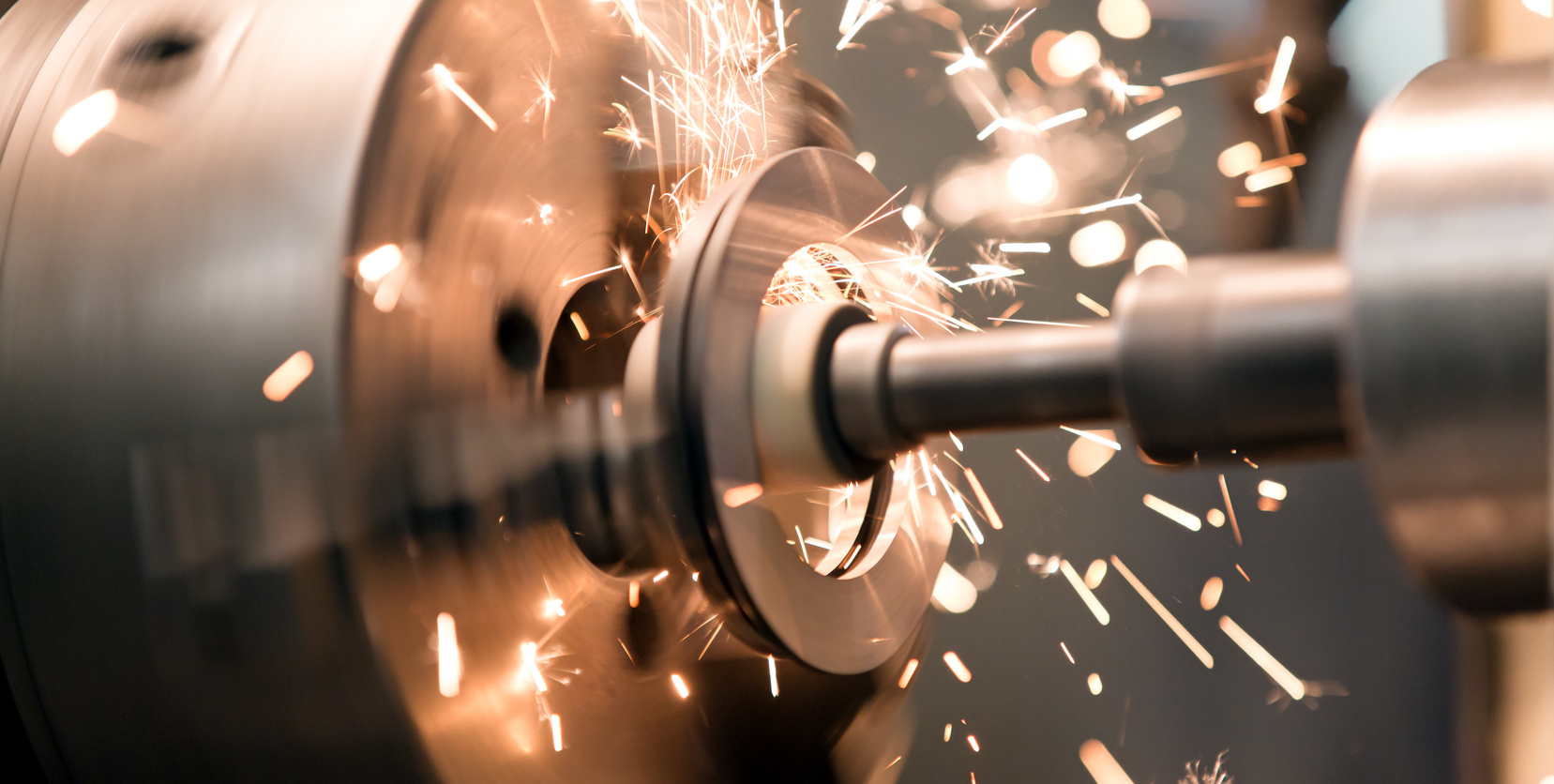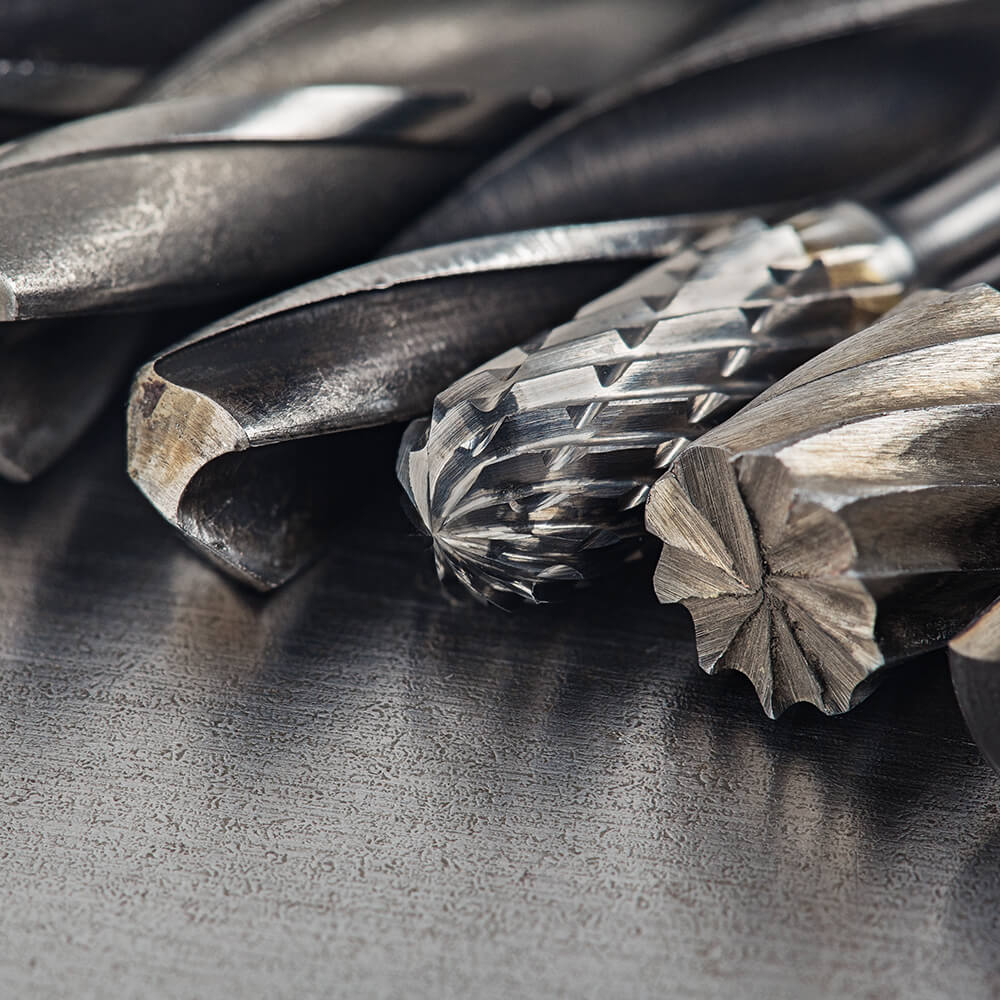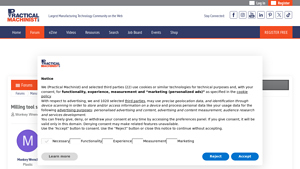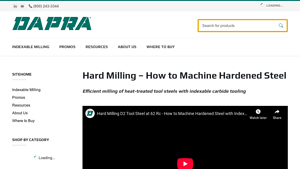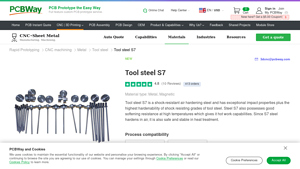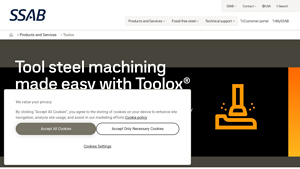Tool Steel Machining Guide: Type, Cost, Top List…
Introduction: Navigating the Global Market for tool steel machining
Navigating the complexities of sourcing high-quality tool steel machining can be a daunting task for international B2B buyers. As industries across Africa, South America, the Middle East, and Europe (including markets like Brazil and Germany) increasingly rely on precision-engineered components, understanding the nuances of tool steel becomes imperative. Tool steel, known for its exceptional hardness and wear resistance, is critical in manufacturing cutting tools, dies, and various machine components. However, the challenge lies in selecting the right type, understanding its applications, and identifying reliable suppliers.
This comprehensive guide addresses these challenges by exploring the different types of tool steel, their specific applications, and essential considerations for machining. From understanding the properties of various alloys to the nuances of heat treatment and machining parameters, this resource equips buyers with the insights needed to make informed purchasing decisions. Moreover, it emphasizes the importance of vetting suppliers to ensure quality and reliability, helping you navigate the global market with confidence.
Whether you’re looking to enhance your production capabilities or seeking to optimize costs, this guide serves as your roadmap in the world of tool steel machining. Empowered with actionable knowledge, you will be better positioned to meet your manufacturing needs while ensuring long-term success in a competitive landscape.
Understanding tool steel machining Types and Variations
| Type Name | Key Distinguishing Features | Primary B2B Applications | Brief Pros & Cons for Buyers |
|---|---|---|---|
| High-Speed Steel | Excellent wear resistance, retains hardness at high temperatures | Cutting tools, milling cutters, drill bits | Pros: High durability; Cons: May require higher initial investment. |
| Tool Steel D2 | High wear resistance, good toughness, and excellent dimensional stability | Dies, molds, automotive parts | Pros: Versatile; Cons: More challenging to machine than other steels. |
| Tool Steel O1 | Oil-hardening, good machinability, and moderate wear resistance | Hand tools, machine components | Pros: Easy to work with; Cons: Less durable than D2 in high-stress applications. |
| Tool Steel A2 | Air-hardening, good toughness, and excellent wear resistance | Molds, dies, and machining applications | Pros: Maintains strength at elevated temperatures; Cons: More expensive than some alternatives. |
| Tool Steel S7 | Shock-resistant, high toughness, and good wear resistance | Impact tools, dies for forging, and metal stamping | Pros: Ideal for high-impact applications; Cons: Requires careful heat treatment to optimize properties. |
What Are the Characteristics and Suitability of High-Speed Steel for Tool Steel Machining?
High-speed steel (HSS) is a preferred choice for many machining applications due to its ability to withstand high temperatures without losing hardness. This makes it particularly suitable for cutting tools, milling cutters, and drill bits used in high-speed operations. When purchasing HSS, buyers should consider the specific grades available, as they can vary in terms of wear resistance and toughness. Additionally, while the initial cost may be higher, the long-term durability can result in lower overall operational costs.
Why Is Tool Steel D2 Popular for B2B Applications?
Tool steel D2 is renowned for its exceptional wear resistance and toughness, making it ideal for applications requiring precision and durability, such as dies and molds. Its ability to maintain dimensional stability during machining is crucial for producing high-quality automotive parts. Buyers should be aware that while D2 offers versatility, it can be more challenging to machine compared to softer steels. Thus, investing in high-quality tooling and machining processes is essential for optimal results.
What Makes Tool Steel O1 a Good Choice for Hand Tools and Machine Components?
Tool steel O1 is an oil-hardening steel known for its good machinability and moderate wear resistance. It is commonly used in the production of hand tools and machine components. Its ease of machining allows for the production of intricate designs, making it a favorite among manufacturers. However, buyers should note that O1 may not be as durable as other tool steels like D2 in high-stress applications, so it’s essential to assess the specific requirements of the application before making a purchase.
How Does Tool Steel A2 Compare to Other Variants?
Tool steel A2 is an air-hardening steel that combines good toughness with excellent wear resistance, making it suitable for molds and dies. Its ability to maintain strength at elevated temperatures is an advantage in various machining applications. Buyers considering A2 should evaluate the cost against its performance benefits, as it tends to be more expensive than other options. Proper heat treatment is also vital to fully leverage its properties, ensuring that the investment pays off in terms of longevity and performance.
In What Scenarios Is Tool Steel S7 Most Effective?
Tool steel S7 is characterized by its shock resistance and high toughness, making it particularly effective for impact tools and dies used in forging and metal stamping. Its ability to absorb shock without cracking is crucial in high-impact applications. Buyers should keep in mind that while S7 offers significant advantages, it requires careful heat treatment to optimize its properties. This consideration is essential for manufacturers looking to ensure reliability and performance in demanding environments.
Key Industrial Applications of tool steel machining
| Industry/Sector | Specific Application of tool steel machining | Value/Benefit for the Business | Key Sourcing Considerations for this Application |
|---|---|---|---|
| Manufacturing | Production of Cutting Tools | Enhanced durability and precision in manufacturing | Availability of high-quality alloys and machining capabilities |
| Automotive | Fabrication of Engine Components | Improved performance and lifespan of automotive parts | Compliance with international standards and certifications |
| Aerospace | Production of Molds for Aerospace Parts | Lightweight, high-strength components for safety | Need for specialized machining services and tight tolerances |
| Construction | Manufacturing of Hand Tools | Increased reliability and efficiency in construction | Sourcing from reputable suppliers with proven track records |
| Energy | Fabrication of Turbine Components | High wear resistance under extreme conditions | Access to advanced heat treatment and machining technologies |
How is Tool Steel Machining Utilized in Manufacturing Cutting Tools?
In the manufacturing sector, tool steel machining is integral to producing cutting tools like drills, milling cutters, and lathe tools. The high wear resistance and heat resistance of tool steel ensure that these tools maintain their sharpness and structural integrity over extended use, thus reducing production downtime. For international buyers, particularly in Africa and South America, sourcing tool steel that meets specific hardness and toughness requirements is crucial for ensuring that the tools can withstand rigorous operational demands.
What Role Does Tool Steel Machining Play in Automotive Fabrication?
In the automotive industry, tool steel is machined to create critical engine components such as crankshafts, camshafts, and transmission gears. The strength and durability of tool steel enhance the performance and longevity of these parts, which are subjected to high stress and wear. Buyers from Europe and the Middle East should consider suppliers who offer precision machining capabilities and can deliver components that comply with stringent automotive standards, ensuring reliability and safety.
How is Tool Steel Machining Important in Aerospace Molds Production?
Tool steel machining is essential for producing molds used in the aerospace sector, where lightweight and high-strength components are vital. The machining process allows for the creation of complex shapes and designs that meet the exacting specifications required in aerospace applications. Buyers must prioritize sourcing from manufacturers with expertise in aerospace-grade materials and machining processes, as well as those who can provide documentation for compliance with industry standards.
Why is Tool Steel Machining Critical for Hand Tool Manufacturing in Construction?
In the construction industry, tool steel is commonly used to manufacture hand tools such as hammers, pliers, and screwdrivers. The toughness and wear resistance of tool steel enhance the reliability and longevity of these tools, making them essential for construction professionals. International buyers should seek suppliers that can provide consistent quality and have a strong reputation for delivering durable tools that can withstand harsh working conditions.
What Benefits Does Tool Steel Machining Offer for Energy Sector Components?
Tool steel machining is pivotal in fabricating turbine components used in the energy sector, particularly in wind and gas turbines. The ability of tool steel to resist wear and maintain performance under extreme conditions is critical for the efficiency and safety of energy production. Buyers in this sector should focus on sourcing from manufacturers that utilize advanced heat treatment and machining technologies to ensure that components meet the rigorous demands of energy applications.
3 Common User Pain Points for ‘tool steel machining’ & Their Solutions
Scenario 1: Difficulty in Selecting the Right Tool Steel for Specific Applications
The Problem: Many B2B buyers face the challenge of selecting the appropriate type of tool steel for their specific machining needs. With various types of tool steels—such as D2, O1, and A2—each offering unique properties like hardness, wear resistance, and machinability, the decision can become overwhelming. Buyers may struggle with understanding which type is best suited for their applications, leading to potential delays in production, increased costs, and suboptimal performance of the final products.
The Solution: To effectively source the right tool steel, buyers should begin by clearly defining the requirements of their application, including factors such as the expected wear conditions, operating temperatures, and specific mechanical properties needed. Conducting thorough research or consulting with material specialists can provide valuable insights into the characteristics of different tool steel grades. Additionally, collaborating with suppliers who offer custom solutions or who can provide sample materials for testing can help in making informed decisions. Engaging in discussions with manufacturers about their production processes and requirements can also lead to tailored recommendations that align with both technical specifications and budget constraints.
Scenario 2: Challenges with Machining Tool Steel Due to Its Hardness
The Problem: Machining tool steel can be particularly challenging due to its inherent hardness, which can lead to excessive tool wear, poor surface finish, and even tool breakage. B2B buyers often report difficulties in achieving precise dimensions and tolerances when working with harder grades of tool steel. This not only affects the quality of the components being produced but can also result in increased operational downtime and costs associated with replacing worn tools.
The Solution: To mitigate these issues, it is crucial to optimize machining parameters, including cutting speed, feed rate, and tool selection. Buyers should consider utilizing high-speed steel (HSS) or carbide tools specifically designed for machining hardened materials. Implementing appropriate cooling techniques, such as using coolant or through-tool coolant systems, can significantly reduce heat buildup and prolong tool life. Additionally, investing in advanced machining technologies, such as CNC machines with higher RPM capabilities, can enhance precision and efficiency. Regular monitoring of tool wear and implementing predictive maintenance practices can further help in maintaining the quality of the machining process.
Scenario 3: Managing Costs and Lead Times in Tool Steel Machining
The Problem: B2B buyers often encounter difficulties in managing costs and lead times associated with tool steel machining. High material costs, combined with the intricacies of machining hard materials, can lead to unexpected budget overruns. Furthermore, delays in sourcing the right tool steel or machining services can negatively impact project timelines, resulting in lost business opportunities and strained client relationships.
The Solution: To address these challenges, buyers should establish strong relationships with reliable suppliers who can provide competitive pricing and consistent quality. Engaging in long-term contracts or bulk purchasing agreements may also yield cost savings. Additionally, evaluating local suppliers can reduce shipping times and costs, thus improving overall lead times. Implementing lean manufacturing principles can streamline operations and minimize waste, contributing to more predictable project timelines. It may also be beneficial to adopt just-in-time (JIT) inventory practices to reduce holding costs and ensure that materials are available when needed without overcommitting resources. By integrating these strategies, B2B buyers can enhance their operational efficiency and maintain better control over costs and timelines.
Strategic Material Selection Guide for tool steel machining
When selecting materials for tool steel machining, it is crucial to consider various factors that impact performance, durability, and cost. Below, we analyze four common tool steel materials, highlighting their properties, advantages, disadvantages, and specific considerations for international B2B buyers.
What are the Key Properties of D2 Tool Steel for Machining?
D2 tool steel is a high-carbon, high-chromium steel known for its exceptional wear resistance and toughness. It typically has a hardness rating of 58-62 HRC and performs well at elevated temperatures, making it suitable for various machining applications. D2 is also resistant to corrosion, although it is not entirely stainless, which is an important consideration in humid environments.
Pros: D2’s excellent wear resistance makes it ideal for cutting tools and dies. Its high hardness allows it to maintain a sharp edge over extended periods, reducing the frequency of tool replacements.
Cons: The high carbon content can make D2 difficult to machine, requiring specialized tooling and techniques. Additionally, its cost can be higher than other tool steels, which may impact budget considerations for smaller operations.
Impact on Application: D2 is particularly effective in applications requiring high durability, such as die-making and high-volume production environments. However, it may not be the best choice for applications exposed to highly corrosive media.
Considerations for International Buyers: Compliance with standards like ASTM A681 is essential for ensuring material quality. Buyers in regions like Africa and South America should also consider local availability and pricing fluctuations.
How Does A2 Tool Steel Compare in Machining Applications?
A2 tool steel is an air-hardening steel known for its versatility and good machinability. It has a hardness range of 57-62 HRC and exhibits excellent toughness and wear resistance, making it suitable for a variety of applications.
Pros: A2 is easier to machine than D2, which can lead to lower manufacturing costs. Its toughness makes it resistant to cracking, making it suitable for tools subjected to impact.
Cons: While A2 offers good wear resistance, it may not perform as well as D2 in high-wear applications. Its cost is moderate, but it can still be a significant investment for small manufacturers.
Impact on Application: A2 is commonly used for making cutting tools, punches, and dies. Its good toughness makes it suitable for applications where tools face shock loads.
Considerations for International Buyers: Buyers should ensure compliance with standards such as ASTM A681 and consider the availability of A2 in local markets, particularly in Europe and the Middle East.
What are the Benefits of M2 High-Speed Steel for Tool Steel Machining?
M2 high-speed steel is renowned for its ability to withstand high temperatures without losing hardness. It typically has a hardness of 62-67 HRC and is often used in cutting tools that require high-speed operations.
Pros: M2’s high-speed capabilities allow for faster machining processes, which can lead to increased productivity. It also offers excellent wear resistance and toughness.
Cons: The cost of M2 can be high, and it requires precise machining parameters to avoid tool wear. Its brittleness can be a concern in some applications.
Impact on Application: M2 is ideal for high-speed machining applications, such as drill bits and milling cutters, where heat generation is significant.
Considerations for International Buyers: Compliance with international standards like ASTM A600 is crucial, especially for buyers in regions with stringent quality controls like Germany.
Why Choose O1 Tool Steel for General Machining Needs?
O1 tool steel is an oil-hardening steel that offers good machinability and is often used for making tools and dies. It has a hardness of 55-62 HRC and is known for its ease of heat treatment.
Pros: O1 is relatively easy to machine, making it a popular choice for general-purpose tools. Its affordability compared to other tool steels can be attractive for budget-conscious manufacturers.
Cons: While O1 offers decent wear resistance, it may not be suitable for high-stress applications where durability is critical. Its corrosion resistance is also limited compared to other tool steels.
Impact on Application: O1 is commonly used in applications requiring moderate wear resistance, such as jigs, fixtures, and hand tools.
Considerations for International Buyers: Buyers should be aware of compliance with ASTM A2 standards and consider the availability of O1 in their local markets.
Summary Table of Tool Steel Materials for Machining
| Material | Typical Use Case for tool steel machining | Key Advantage | Key Disadvantage/Limitation | Relative Cost (Low/Med/High) |
|---|---|---|---|---|
| D2 | Cutting tools, dies | Excellent wear resistance | Difficult to machine | High |
| A2 | Punches, dies | Good machinability | Moderate wear resistance | Medium |
| M2 | High-speed cutting tools | High-temperature resistance | Brittle, requires precise machining | High |
| O1 | Jigs, fixtures, hand tools | Easy to machine | Limited wear resistance | Low |
This strategic material selection guide provides insights into the key properties and considerations for various tool steels used in machining. By understanding these factors, international B2B buyers can make informed decisions that align with their operational needs and market conditions.
In-depth Look: Manufacturing Processes and Quality Assurance for tool steel machining
What Are the Main Stages of Tool Steel Machining Manufacturing Processes?
When it comes to machining tool steel, a structured approach to the manufacturing process is essential for producing high-quality components that meet industry demands. The key stages involved in the manufacturing process include material preparation, forming, assembly, and finishing.
How Is Material Prepared for Tool Steel Machining?
Material preparation begins with selecting the right type of tool steel, which could include various alloys such as D2, A2, or O1, depending on the application. The steel is typically supplied in an annealed state, making it easier to machine. It is crucial for buyers to ensure that the material meets the required specifications, as variations in composition can significantly affect the final product’s performance.
After selecting the appropriate tool steel, the next step involves cutting the material into manageable sizes. This often involves using band saws or shearing processes. Precision is critical here, as any inaccuracies can lead to complications in subsequent machining stages. Buyers should verify that suppliers use calibrated equipment to ensure consistent cutting tolerances.
What Techniques Are Commonly Used in Forming Tool Steel?
The forming stage of tool steel machining employs various techniques, including milling, turning, and grinding. Each method has its unique advantages and is chosen based on the specific requirements of the component being manufactured.
Milling is particularly effective for producing complex shapes and slots. High-speed steel (HSS) or carbide end mills are commonly used, with recommended speeds and feeds tailored to the specific tool steel grade. For instance, when machining tool steel, a common RPM might be around 2000, with a feed rate of 0.0015 inches per tooth. The choice of tooling directly impacts the quality of the finished product, making it essential for buyers to inquire about tooling standards and capabilities.
Turning is another vital process, especially for cylindrical components. CNC lathes are frequently utilized to achieve high precision, and the tooling must be suited for the hardness of the material. Grinding is often the final step in achieving tight tolerances and smooth surface finishes, making it critical for components that require high dimensional accuracy.
How Are Tool Steel Components Assembled and Finished?
Assembly often involves fitting machined components together, which may require further adjustments to ensure proper alignment and functionality. Buyers should ensure that suppliers have robust assembly protocols in place to minimize errors.
Finishing processes such as heat treatment, coating, or polishing are crucial for enhancing the performance characteristics of tool steel. Heat treatment, in particular, allows for the adjustment of hardness levels and improves wear resistance. Buyers should verify that their suppliers adhere to specific heat treatment protocols that align with international standards.
What Quality Assurance Measures Should Be in Place for Tool Steel Machining?
Quality assurance (QA) is a fundamental aspect of tool steel machining, ensuring that the final products meet both buyer specifications and international standards. Various QA checkpoints and testing methods are integral to the process.
Which International Standards Apply to Tool Steel Machining?
Adhering to international quality standards such as ISO 9001 is critical for manufacturers aiming to maintain a competitive edge. ISO 9001 sets the framework for quality management systems, focusing on customer satisfaction and continuous improvement. In addition to ISO, industry-specific standards such as CE marking for European markets or API specifications for the oil and gas industry may apply.
What Are the Key Quality Control Checkpoints During Manufacturing?
Quality control (QC) checkpoints typically include Incoming Quality Control (IQC), In-Process Quality Control (IPQC), and Final Quality Control (FQC).
-
IQC: This stage involves inspecting the raw materials upon receipt to ensure they meet specified standards before any processing begins.
-
IPQC: Throughout the machining process, in-process inspections are conducted to monitor adherence to tolerances and specifications. This may involve measuring dimensions, checking surface finishes, and assessing tooling wear.
-
FQC: Final inspections are performed to verify that the finished products meet all requirements before they are shipped to the buyer. This may include functional testing, dimensional checks, and visual inspections.
How Can B2B Buyers Verify Supplier Quality Control Practices?
B2B buyers can take several steps to verify a supplier’s quality control practices. Conducting audits of the manufacturing facilities can provide insight into the supplier’s processes and adherence to quality standards. Additionally, buyers should request access to quality reports, which detail inspection results and compliance with relevant standards.
Engaging third-party inspection services can also enhance confidence in the supplier’s capabilities. These independent entities can perform objective assessments of the manufacturing processes and final products, ensuring compliance with international standards.
What Are the Nuances of Quality Control for International B2B Buyers?
For international buyers, particularly those from Africa, South America, the Middle East, and Europe, understanding the nuances of quality control is vital. Different regions may have varying standards, regulations, and expectations for quality assurance.
Buyers should be aware of the specific certifications that may be required for their market. For instance, European buyers may prioritize CE certifications, while Middle Eastern clients might focus on compliance with local standards. Understanding these regional differences can help buyers navigate the complexities of international trade and ensure they are receiving products that meet their expectations.
Moreover, engaging in continuous communication with suppliers about quality expectations can foster a more transparent relationship, enhancing trust and ensuring that both parties are aligned on quality objectives.
In conclusion, a thorough understanding of the manufacturing processes and quality assurance measures in tool steel machining is essential for B2B buyers. By focusing on material preparation, forming techniques, assembly and finishing processes, as well as robust quality control practices, buyers can ensure they receive high-quality components that meet their specific needs.
Practical Sourcing Guide: A Step-by-Step Checklist for ‘tool steel machining’
To effectively procure tool steel machining services, a structured approach is essential. This guide serves as a checklist to help B2B buyers streamline their sourcing process, ensuring they choose the right suppliers and materials to meet their specific needs.
Step 1: Define Your Technical Specifications
Understanding your machining requirements is the foundation of the procurement process. Clearly specify the type of tool steel you need (e.g., D2, O1, A2) and the desired characteristics such as hardness, ductility, and wear resistance. This clarity helps suppliers provide accurate quotes and ensures that the finished product meets your expectations.
Step 2: Research Potential Suppliers
Conduct thorough research to identify suppliers with expertise in tool steel machining. Look for companies that specialize in your specific type of tool steel and have experience in your industry. Online reviews, industry forums, and supplier directories can provide insights into their reputation and reliability.
Step 3: Evaluate Supplier Certifications
Before making a decision, verify that potential suppliers hold relevant certifications. Look for ISO certifications or other industry standards that indicate a commitment to quality. These certifications can assure you that the supplier adheres to best practices in machining and material handling, ultimately minimizing risks in your supply chain.
Step 4: Request Samples and Prototypes
Requesting samples or prototypes is a critical step in assessing the quality of a supplier’s work. This allows you to evaluate their machining capabilities and the precision of their finished products. Pay attention to the dimensional accuracy and surface finish, as these factors can significantly impact the performance of your tools.
Step 5: Discuss Machining Processes and Techniques
Engage with suppliers to understand their machining processes. Inquire about the types of equipment they use, as well as their capabilities in terms of milling, grinding, and heat treatment. A supplier’s ability to employ advanced techniques can enhance the quality and efficiency of the machining process.
Step 6: Assess Lead Times and Production Capacity
Discuss lead times and the supplier’s production capacity to ensure they can meet your timelines. Understanding their ability to scale production based on your needs is vital, especially if you anticipate fluctuating demand. A reliable supplier should provide clear timelines and the flexibility to adjust as necessary.
Step 7: Negotiate Terms and Pricing
Once you have narrowed down your options, engage in discussions about pricing and payment terms. Ensure that you understand the total cost of ownership, including any additional fees for tooling, shipping, or expedited processing. Transparent negotiations can lead to a mutually beneficial agreement that aligns with your budget and quality expectations.
By following this structured checklist, B2B buyers can navigate the complexities of sourcing tool steel machining services with confidence, ensuring they select suppliers that align with their technical requirements and business goals.
Comprehensive Cost and Pricing Analysis for tool steel machining Sourcing
What Are the Key Cost Components in Tool Steel Machining?
When sourcing tool steel machining services, understanding the cost structure is vital for B2B buyers. The primary cost components include:
-
Materials: Tool steel itself is a significant expense, with prices varying based on alloy type, quality, and market fluctuations. Premium alloys, like D2 or M2 tool steel, may command higher prices due to their enhanced properties.
-
Labor: Skilled labor is essential for machining tool steel due to its toughness and the precision required. Labor costs can vary significantly across regions, with countries like Germany often having higher labor costs compared to emerging markets in Africa or South America.
-
Manufacturing Overhead: This encompasses costs related to facility maintenance, utilities, and administrative expenses. Efficient facilities can reduce overhead, thus impacting overall pricing.
-
Tooling: Specialized tooling is necessary for machining tool steel effectively. This includes high-speed steel or carbide end mills, which are more expensive but necessary for achieving high-quality finishes. The cost of tooling can be amortized over production runs, influencing pricing.
-
Quality Control (QC): Implementing stringent QC measures ensures that the final product meets specifications. This may involve additional labor and equipment costs, which can be reflected in the overall pricing.
-
Logistics: Shipping and handling costs are particularly relevant for international buyers. Incoterms play a crucial role here, as they define the responsibilities of buyers and sellers regarding transportation costs and risk.
-
Margin: Suppliers typically add a margin to cover risks and ensure profitability. This margin can vary based on supplier reputation, market demand, and competition.
How Do Price Influencers Affect Tool Steel Machining Costs?
Several factors can influence the pricing of tool steel machining:
-
Volume and Minimum Order Quantity (MOQ): Larger orders often result in lower per-unit costs due to economies of scale. Conversely, small orders may incur higher costs due to setup and tooling expenses.
-
Specifications and Customization: Custom parts that require unique designs or tolerances can drive up costs. Buyers should clearly define their requirements to avoid unexpected charges.
-
Materials: The choice of material significantly affects pricing. High-performance steels or those requiring special treatments will be more expensive than standard options.
-
Quality and Certifications: Suppliers offering certified materials (e.g., ISO or ASTM standards) may charge a premium. Buyers should weigh the importance of certifications against potential cost savings.
-
Supplier Factors: Established suppliers with a reputation for quality and reliability may charge higher prices. However, their experience can reduce risks associated with machining tool steel.
-
Incoterms: Understanding the terms of shipping can help in negotiating better pricing. Different Incoterms can alter the total cost due to variations in shipping responsibilities.
What Are the Best Negotiation Tips for Buyers Sourcing Tool Steel Machining?
To ensure cost-effectiveness when sourcing tool steel machining, consider these buyer tips:
-
Negotiate Volume Discounts: If you anticipate ongoing needs, negotiate for bulk pricing. Establishing a long-term relationship with suppliers can also lead to better terms.
-
Focus on Total Cost of Ownership (TCO): Evaluate not just the upfront costs but also long-term expenses, including maintenance, operational efficiency, and potential downtime. A lower initial price may not always equate to better value.
-
Understand Pricing Nuances for International Sourcing: Different regions have varying cost structures. For instance, while sourcing from Europe may offer high-quality standards, it could also mean higher costs compared to suppliers in South America or Africa.
-
Request Multiple Quotes: Gathering quotes from several suppliers allows for comparative analysis and helps identify competitive pricing.
-
Build Relationships: Establishing rapport with suppliers can lead to better pricing, priority service, and potential discounts on future orders.
Conclusion
Understanding the comprehensive cost and pricing dynamics in tool steel machining is crucial for international B2B buyers. By considering the outlined cost components and influencers, buyers can make informed decisions that align with their operational needs and budget constraints. Always keep in mind that pricing can fluctuate based on market conditions, and it’s advisable to stay updated on industry trends to negotiate effectively.
Alternatives Analysis: Comparing tool steel machining With Other Solutions
Exploring Alternatives to Tool Steel Machining
In the realm of manufacturing and metalworking, tool steel machining is a widely recognized method for producing high-strength, durable components. However, various alternative solutions exist that can fulfill similar requirements depending on specific application needs, budget constraints, and production scales. Understanding these alternatives can empower international B2B buyers to make informed decisions that align with their operational goals.
| Comparison Aspect | Tool Steel Machining | Alternative 1: CNC Machining | Alternative 2: Casting |
|---|---|---|---|
| Performance | Excellent wear resistance; high precision | High precision; versatile materials | Good for complex shapes; less precise |
| Cost | Moderate to high due to tooling and time | Higher initial investment; efficient | Generally lower; setup cost can vary |
| Ease of Implementation | Requires skilled labor and precise tooling | User-friendly with automated systems | Less skill-intensive; setup complexity |
| Maintenance | Tool wear necessitates regular changes | Low maintenance; automated systems | Less frequent maintenance; can be costly |
| Best Use Case | Cutting tools, dies, molds | High-precision components, prototypes | Large production runs of complex parts |
What Are the Advantages and Disadvantages of CNC Machining as an Alternative?
CNC (Computer Numerical Control) machining is an advanced manufacturing method that automates the machining process through computer programming. The primary advantage of CNC machining lies in its ability to produce highly complex and precise components with minimal human intervention. This method is particularly effective for prototyping and producing small to medium runs of intricate designs. However, CNC machining typically requires a higher initial investment in equipment and software. Moreover, while it can handle various materials, the setup and programming phase can be time-consuming.
How Does Casting Compare to Tool Steel Machining?
Casting is a manufacturing process that involves pouring molten metal into a mold to create parts. This method is particularly advantageous for producing complex shapes and large quantities, making it cost-effective for mass production. Casting allows for significant design flexibility, accommodating intricate designs that may be challenging to achieve through machining. However, casting often results in lower dimensional precision compared to tool steel machining and may require additional finishing processes. The initial setup for casting can also be complex and costly, particularly for unique designs.
Which Solution Should B2B Buyers Choose for Their Needs?
When selecting between tool steel machining and its alternatives, B2B buyers should consider several factors, including the specific application, budget, production volume, and required precision. Tool steel machining is ideal for high-stress applications requiring durability and wear resistance, such as cutting tools and dies. Conversely, CNC machining offers versatility and precision for intricate components, while casting is suitable for high-volume production of complex shapes.
Ultimately, the best approach will depend on the unique needs of the project, including performance requirements and cost constraints. Engaging with suppliers and conducting a thorough analysis of each method can help buyers choose the most effective solution for their manufacturing needs.
Essential Technical Properties and Trade Terminology for tool steel machining
What Are the Key Technical Properties of Tool Steel Machining?
When engaging in tool steel machining, understanding the critical specifications is essential for ensuring quality and performance. Here are some vital properties:
1. Material Grade
The material grade of tool steel indicates its composition and properties. Common grades include D2, A2, and O1, each with distinct characteristics such as wear resistance, toughness, and heat treatability. B2B buyers must select the appropriate grade based on the application requirements, as this choice significantly affects the longevity and efficiency of tools and components produced.
2. Hardness
Measured on the Rockwell scale, hardness is a crucial property that indicates a tool steel’s resistance to deformation and wear. For instance, tool steels can range from 50 to 65 HRC (Rockwell Hardness). A higher hardness often correlates with improved wear resistance, making it vital for applications requiring durability. Buyers should assess the hardness requirements based on their operational environment to avoid premature wear or failure.
3. Tolerance
Tolerance refers to the permissible limit of variation in a physical dimension of a machined part. Tight tolerances are crucial in applications where precision is paramount, such as in aerospace and medical devices. Understanding tolerance levels helps buyers ensure that the components meet functional and assembly requirements, reducing the risk of costly rework or failures.
4. Machinability
Machinability describes how easily a material can be machined into desired shapes and sizes. Tool steels are generally known for good machinability, but this can vary significantly based on the alloy and heat treatment. Understanding machinability is essential for selecting the right tooling and cutting parameters, leading to optimized production efficiency and reduced tool wear.
5. Heat Treatability
Heat treatability indicates a material’s ability to undergo heat treatment processes to enhance its properties, such as hardness and toughness. Tool steels are often heat-treated to achieve desired performance characteristics. B2B buyers must consider the heat treatability of tool steel to ensure that it can withstand the operational stresses it will encounter in service.
6. Surface Finish
Surface finish is a measure of the texture of a machined surface, which can impact functionality and aesthetics. In tool steel machining, achieving the right surface finish is critical for reducing friction, enhancing wear resistance, and ensuring proper fit in assemblies. Buyers should specify surface finish requirements to align with their application standards.
What Are Common Trade Terms in Tool Steel Machining?
Navigating the tool steel machining industry requires familiarity with specific terminology. Here are some commonly used terms:
1. OEM (Original Equipment Manufacturer)
OEM refers to a company that produces parts or equipment that may be marketed by another manufacturer. In tool steel machining, understanding OEM relationships can help buyers source high-quality components tailored to their needs.
2. MOQ (Minimum Order Quantity)
MOQ indicates the smallest quantity of a product that a supplier is willing to sell. For tool steel, MOQs can affect procurement strategies, especially for smaller businesses. Buyers should negotiate MOQs to optimize inventory management and cost efficiency.
3. RFQ (Request for Quotation)
An RFQ is a document sent to suppliers requesting pricing and terms for specific products or services. In tool steel machining, submitting RFQs helps buyers compare offers and negotiate better terms, ensuring they receive competitive pricing.
4. Incoterms (International Commercial Terms)
Incoterms define the responsibilities of buyers and sellers in international trade, including shipping, insurance, and tariffs. Familiarity with Incoterms is crucial for B2B buyers in tool steel machining, as it affects delivery timelines, costs, and risk management.
5. Lead Time
Lead time refers to the amount of time required to fulfill an order from the moment it is placed until it is delivered. Understanding lead times is vital for buyers to plan production schedules effectively and minimize downtime.
By grasping these essential technical properties and trade terminologies, B2B buyers can make informed decisions that enhance their tool steel machining operations and lead to improved product quality and efficiency.
Navigating Market Dynamics and Sourcing Trends in the tool steel machining Sector
What Are the Global Drivers Impacting the Tool Steel Machining Market?
The tool steel machining sector is currently influenced by several global drivers that shape its market dynamics. One of the most significant trends is the increasing demand for high-performance machining tools across various industries, including automotive, aerospace, and manufacturing. This demand is fueled by the need for precision, durability, and the ability to withstand extreme conditions, which tool steel inherently offers. Furthermore, advancements in B2B technology, such as Industry 4.0 and smart manufacturing, are revolutionizing machining processes. Automation, data analytics, and IoT integration are enabling manufacturers to optimize their operations, enhance productivity, and reduce costs.
Emerging sourcing trends are also notable, with a shift towards just-in-time inventory systems and digital procurement platforms. Buyers from Africa, South America, the Middle East, and Europe are increasingly seeking reliable suppliers who can provide high-quality tool steel with efficient delivery times. Additionally, regional market dynamics are evolving, with countries like Brazil and Germany leading in technological adoption and innovation. These nations are investing heavily in R&D to improve tool steel properties and machining techniques, making them pivotal players in the global landscape.
How Is Sustainability Shaping Sourcing in the Tool Steel Machining Industry?
Sustainability is becoming a critical consideration in the tool steel machining sector. The environmental impact of manufacturing processes and the sourcing of raw materials is under increased scrutiny. B2B buyers are now prioritizing suppliers who demonstrate a commitment to reducing their carbon footprint and implementing eco-friendly practices. This includes the use of recycled materials in tool steel production and the adoption of energy-efficient manufacturing techniques.
Ethical sourcing is equally important, as businesses aim to ensure that their supply chains are transparent and socially responsible. Certifications such as ISO 14001 for environmental management and Fair Trade standards are gaining traction among international buyers. These certifications not only enhance brand reputation but also align with the growing consumer demand for sustainable products. As a result, companies that prioritize sustainability and ethical sourcing are likely to gain a competitive edge in the market, appealing to conscientious buyers across Africa, South America, the Middle East, and Europe.
What Is the Historical Context of Tool Steel Machining in B2B?
The evolution of tool steel machining can be traced back to the industrial revolution, where the demand for durable and high-performing tools became paramount. Initially, tool steel was limited to basic applications, but as industries advanced, the need for specialized alloys emerged. By the mid-20th century, innovations in metallurgy led to the development of various tool steel grades, each tailored for specific applications, such as D2 for its wear resistance and O1 for its machinability.
The introduction of advanced machining techniques, including CNC machining and precision grinding, further propelled the industry forward. Today, tool steel machining stands at the intersection of tradition and technology, blending time-tested practices with modern innovations. This historical context provides valuable insights for B2B buyers as they navigate the complexities of sourcing high-quality tool steel in a rapidly evolving market.
Frequently Asked Questions (FAQs) for B2B Buyers of tool steel machining
-
1. How do I solve challenges in machining tool steel?
Machining tool steel can be challenging due to its hardness and wear resistance. To effectively address these challenges, it’s essential to select the right tooling—preferably high-speed steel or carbide end mills—and to optimize machining parameters such as spindle speed and feed rate. Incorporating coolant can significantly improve cutting performance and tool longevity by reducing heat buildup. Additionally, using a multi-pass approach for deeper cuts will help maintain precision and minimize tool breakage, ensuring a smoother machining process. -
2. What is the best type of tool steel for high-wear applications?
D2 tool steel is often regarded as one of the best options for high-wear applications due to its exceptional hardness and wear resistance. It is an air-hardening steel that can achieve high hardness levels after heat treatment, making it suitable for cutting tools, dies, and molds. Other options include A2 and O1 tool steels, which also offer good wear resistance and machinability. The choice of tool steel should be based on the specific application requirements, including the type of wear expected and the machining conditions. -
3. What factors should I consider when selecting a tool steel supplier?
When selecting a tool steel supplier, consider their experience in the industry, product range, and quality certifications such as ISO 9001. Evaluate their ability to provide custom solutions and their lead times for delivery, especially for international orders. Additionally, check customer reviews and references to assess their reliability and service levels. It’s also beneficial to inquire about their sourcing practices to ensure that the raw materials meet your quality standards. -
4. What are the typical minimum order quantities (MOQs) for tool steel machining?
Minimum order quantities for tool steel machining can vary significantly between suppliers. While some may require a minimum of 500 kg, others might accommodate smaller orders based on your specific needs. It is advisable to discuss your project requirements with potential suppliers to determine their flexibility regarding MOQs. Additionally, consider the cost implications of smaller orders, as larger quantities may yield better pricing and reduce overall production costs. -
5. How can I ensure the quality of machined tool steel parts?
To ensure the quality of machined tool steel parts, implement a robust quality assurance (QA) process that includes regular inspections and testing. Request certifications from suppliers that verify the material properties and machining tolerances. Utilize advanced inspection tools such as coordinate measuring machines (CMM) to assess dimensions accurately. Establish clear specifications and standards for your projects, and maintain open communication with your supplier to address any quality concerns promptly. -
6. What payment terms are common in international tool steel transactions?
Common payment terms for international transactions in tool steel machining often include upfront deposits ranging from 30% to 50%, with the balance due upon delivery or after inspection. Some suppliers may offer payment via letters of credit or escrow services for larger orders to mitigate risks. It is crucial to clarify payment terms in advance and ensure that both parties are comfortable with the arrangement to avoid misunderstandings during the transaction. -
7. What logistics considerations should I keep in mind when sourcing tool steel internationally?
When sourcing tool steel internationally, consider shipping costs, transit times, and customs regulations in your country. Choose a reliable logistics partner experienced in handling industrial materials to minimize delays. Be aware of the specific import duties and taxes applicable to tool steel in your region. Additionally, ensure that the supplier can provide necessary shipping documentation, such as certificates of origin and compliance, to facilitate a smooth customs process. -
8. How do I customize tool steel components for specific applications?
Customizing tool steel components requires a clear understanding of the application requirements, including dimensions, tolerances, and material properties. Collaborate closely with your supplier during the design phase, providing detailed specifications and any unique machining processes needed. Some suppliers may offer prototyping services to test the design before full-scale production. Discuss heat treatment options to achieve desired hardness and performance characteristics tailored to your application.
Important Disclaimer & Terms of Use
⚠️ Important Disclaimer
The information provided in this guide, including content regarding manufacturers, technical specifications, and market analysis, is for informational and educational purposes only. It does not constitute professional procurement advice, financial advice, or legal advice.
While we have made every effort to ensure the accuracy and timeliness of the information, we are not responsible for any errors, omissions, or outdated information. Market conditions, company details, and technical standards are subject to change.
B2B buyers must conduct their own independent and thorough due diligence before making any purchasing decisions. This includes contacting suppliers directly, verifying certifications, requesting samples, and seeking professional consultation. The risk of relying on any information in this guide is borne solely by the reader.
Top 9 Tool Steel Machining Manufacturers & Suppliers List
1. Practical Machinist – A-2 Tool Steel
Domain: practicalmachinist.com
Registered: 2000 (25 years)
Introduction: Tool Steel: A-2, 1″ x 1/4″; Characteristics: Chrome and tungsten content, expect cutter wear; Recommended Tooling: High-speed steel endmills (3/32″ and 1/8″), carbide endmills (if machine speed allows); Cutting Parameters: 2000 RPM, feed rate of 0.0015″ per tooth; Recommended Techniques: Use slitting saw in horizontal mill if available, otherwise use endmills in vertical spindle; Cooling: Use cool…
2. Reddit – Machining Tool Steel Guide
Domain: reddit.com
Registered: 2005 (20 years)
Introduction: Machining tool steel and injection molds involves several key steps: 1. Material is typically purchased in an annealed state. 2. Rough machining is done up to a specified distance from the target dimensions. 3. A hardening treatment is applied. 4. A tempering treatment follows. 5. Final machining is performed to achieve the target dimensions. The amount of buffer material left for final machining …
3. Dapra – Indexable Carbide Tooling for Hard Milling
Domain: dapra.com
Registered: 1996 (29 years)
Introduction: Efficient milling of heat-treated tool steels with indexable carbide tooling. Key tips for successful hard milling include: 1. Use a strong insert geometry, like a button (round) insert. 2. Use a strong cutting edge – a T-land or K-land insert can better hold up to the stress. 3. Use a very hard grade of carbide that can handle heat without deformation. 4. Use a high-temp coating designed for hard…
4. Iscar – FF EWXD0.62-2-1.5W0.62-04
Domain: emastercam.com
Registered: 1999 (26 years)
Introduction: Iscar FF EWXD0.62-2-1.5W0.62-04, Iscar penta turn
5. PCBWay – Tool Steel S7
Domain: pcbway.com
Registered: 2012 (13 years)
Introduction: {“Material Type”:”Metal, Magnetic”,”Material Name”:”Tool steel S7″,”Description”:”Shock-resistant air hardening steel with exceptional impact properties and high hardenability. Good softening resistance at high temperatures, suitable for hot work capabilities. Safe and stable in heat treatment.”,”Process Compatibility”:[“CNC Milling”,”CNC Turning”],”Material Color”:”Silver gray”,”Material Advantag…
6. Eng-Tips – M2 Tool Steel Guide
Domain: eng-tips.com
Registered: 1997 (28 years)
Introduction: M2 tool steel is a type of tool steel that is known for its hardness. It is recommended to machine M2 steel in its annealed state for easier machining. After machining, it should be heat treated to harden it. The material can be purchased in an annealed condition, and it is advised to perform as much machining as possible before heat treatment to minimize costs. M2 tool steel has minimal movement …
7. SSAB – Toolox Tool Steel
Domain: ssab.com
Registered: 1996 (29 years)
Introduction: Toolox tool steel is designed for easier and faster machining compared to standard steels. It features a low carbon concept with low carbide content, which enhances machinability. The steel is alloyed with molybdenum, niobium, and other elements to further improve machinability. Toolox 44 allows deeper cuts and longer insert lifetimes than traditional tool steels. Compared to standard steel 1.2312…
8. Makerverse – CNC Machined Steel Components
Domain: makerverse.com
Registered: 2012 (13 years)
Introduction: CNC Machining with Steel offers options for stainless and tool steel in manufacturing projects. Key advantages of CNC machined steel components include:
– Strength and Durability: High tensile strength suitable for long-lasting components.
– Heat Resistance: Can withstand higher temperatures than many metals.
– Versatility in Finishing: Quick surface finishing for aesthetics and resistance.
– Mach…
9. JustWay – Key Tool Steel
Domain: justway.com
Registered: 2002 (23 years)
Introduction: Tool steel refers to a variety of carbon steel and alloy steel that are particularly well-suited to be made into tools. Their suitability comes from their distinctive hardness, resistance to abrasion and deformation, and their ability to hold a cutting edge at elevated temperatures.
Key Tool Steel Types:
1. Tool Steel D2: High-carbon, high-chromium, air-hardening tool steel with high hardness an…
Strategic Sourcing Conclusion and Outlook for tool steel machining
Why is Strategic Sourcing Critical for Tool Steel Machining?
In the dynamic landscape of tool steel machining, strategic sourcing stands out as a pivotal element for international B2B buyers. Understanding the nuances of different tool steel grades and machining processes not only enhances operational efficiency but also significantly reduces costs. By partnering with reliable suppliers who prioritize quality and provide tailored solutions, businesses can ensure longevity and performance in their tooling applications.
How Can Buyers Enhance Their Sourcing Strategies?
Investing in advanced machining technologies and selecting the right tooling is essential for maximizing productivity. As tool steels are known for their wear resistance and heat treatability, leveraging these properties can lead to superior product outcomes. Moreover, engaging in long-term relationships with suppliers can result in better pricing structures and access to innovative materials and techniques.
What’s Next for International B2B Buyers?
As the demand for high-quality machining continues to rise in regions such as Africa, South America, the Middle East, and Europe, buyers are encouraged to stay ahead of industry trends. Embrace the potential of global sourcing strategies to enhance competitiveness and foster sustainable growth. By prioritizing strategic sourcing in tool steel machining, businesses can navigate future challenges and seize new opportunities in a rapidly evolving market.
